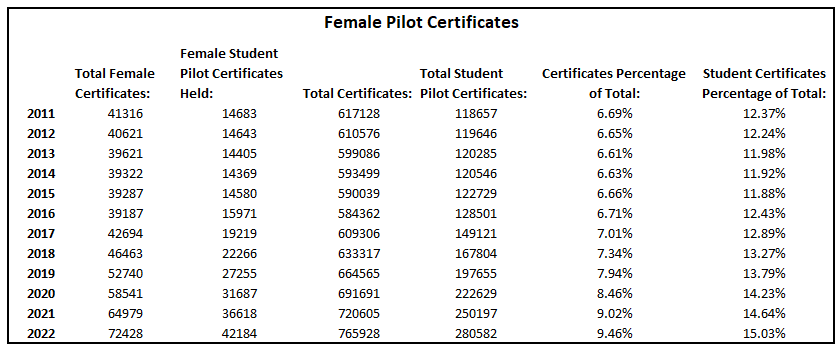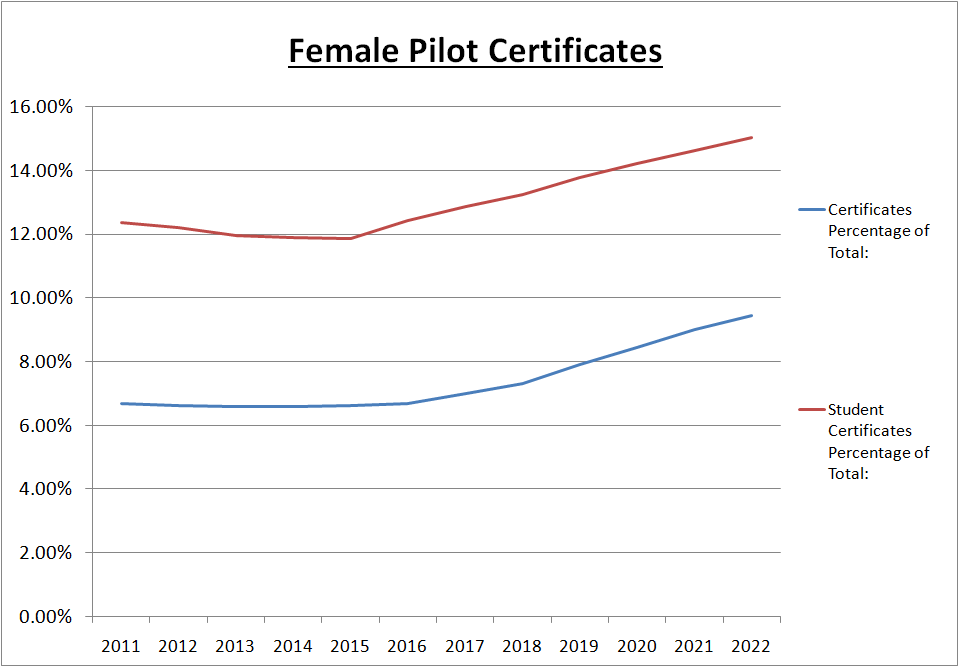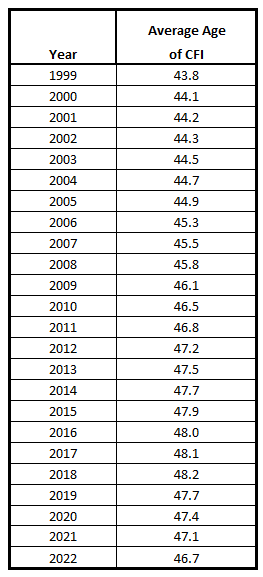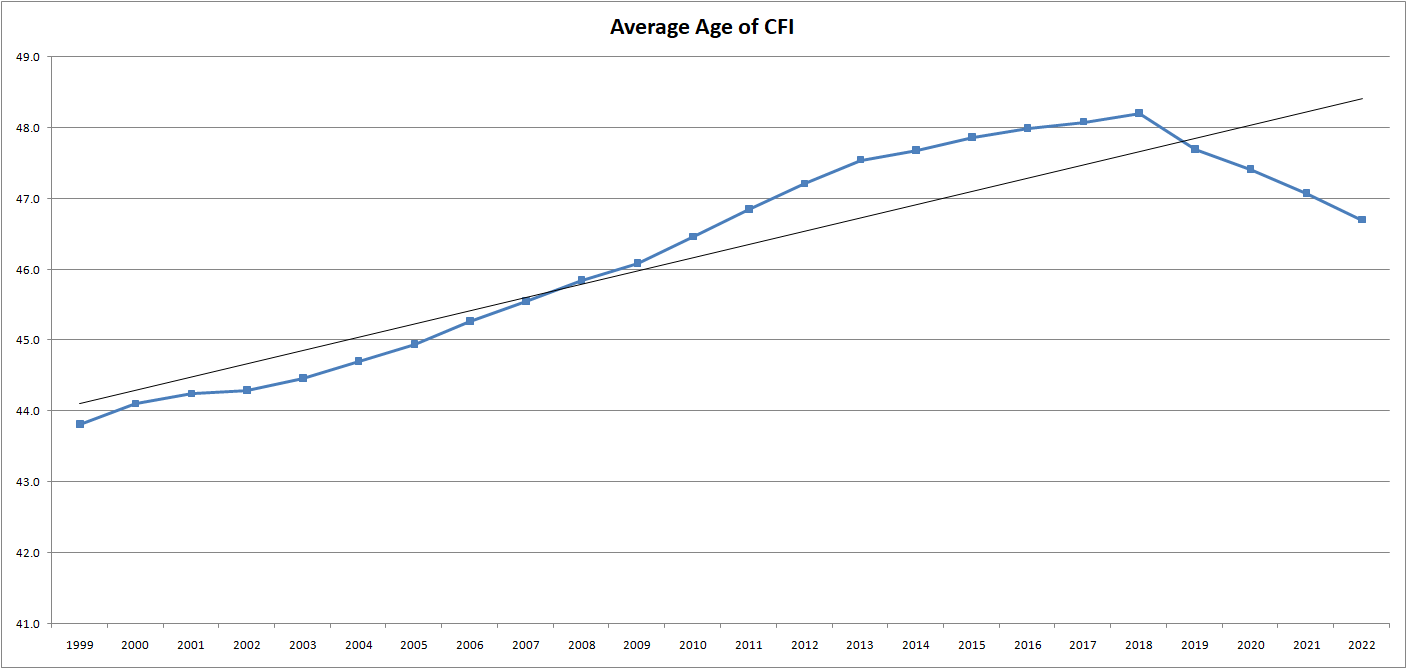Some of the less commonly followed airman certification data points includes how we are doing with increasing the number of females pilots, how our CFI certification numbers are tracking, and a personal curiosity, what percentage of ATPs are being issued as Restricted ATPs.
So, I did a little digging into these numbers and here is what I found.
Female Pilot Certification Numbers Continue to Increase; Barely.
We all know that there are fewer female pilots in the system than there are males. That number has been increasing, but it is a slow pace. Our 2022 certification (and student pilot certificate issuance) numbers again showed increase, but it is a slow increase when it comes to the overall percentage of the pilot population. It is better than a decrease, but we all wish our representation of female pilot was a greater percentage of the overall population.
Here is what it looked like with the 2022 numbers included. Progress, but slow.


Age of CFIs Declining; Percentage of Old CFIs Increasing.
 I think an interesting data point has been the age of CFIs.
I think an interesting data point has been the age of CFIs.
In general, we saw an increasing average age of CFIs for a number of years. And we are now seeing a decrease in this average age of CFIs.
We have LOTS of technically “certificated” CFIs out in our system, but the majority of them are flying as professional pilots with “day jobs” and not actively flight instructing or are at or beyond the age of normal retirement. We will get back to that in a bit.
In the last couple of years however we have seen the age of CFIs starting to again decline. This is related to the influx of larger numbers of newly certificated CFIs in the past couple of years who are seeking to be CFIs to gain experience time and then move on to professional pilotage jobs. The increase of “new CFIs” at younger ages is starting to off-set the older balance of the numbers of CFIs and decrease the average age of the CFI pool.
This isn’t the whole story though and it doesn’t mean that our older CFIs aren’t still out there as a part of our system. In fact, it is the middle of the pool that might in fact be missing a bit.

If we dig a little deeper into this number concept, we see that while our average age of CFI is declining, our representation of the CFIS is weighting heavier toward the old and the young end of the spectrum.

We can see that the number of CFIs who are over the age of 65 and 70 are making up a bigger and bigger percentage of our overall CFI pool while at the same time so are the numbers who are under the age of 30.
Our industry can expect a large percentage of those who are under the age of 30 to transition through the CFI job and to professional pilotage jobs in a year or two in their career. We should not expect them to be active participants in the training process for future generations of pilots as we need them, and the experience they gained as CFIs to do so, to fly as professional pilots in many environments.
Not to be overly harsh, but, we can expect those CFIs who are over the age of 65-70 to start dying off. It’s an actuarial fact that the average of death of men in the United states is a little over 77 years of age. Our CFI certificate holders who are approaching or beyond this age will begin dying. If that is a large percentage of our overall CFI population, we should expect that percentage of the population of CFIs to start to be represented by lower numbers in the upcoming decades. Our matrix of CFI population is set to change with age demographics like much of our aging pilot population. This will likely result in a decrease in overall CFI certificate holder population at some point. Not that that number is a real measure of training production output potential anyway though.
What about the R-ATPs
The Restricted ATP certificate is many times perceived to be a large percentage of our pilot population that is becoming qualified to fly in airline service. When we look though at the percentage of ATP certificate issuances that are R-ATP certificates, it is not as significant as some might think.

It, the percentage of ATP certificates as R-ATP, increased from its inception to level out somewhere in the 30% range of overall ATP certificates issued. Most of these certificates are being issued to candidates who have transited through the collegiate training environment and it now represents somewhere about 1/3 of the total ATP certificate issued each year. That means that a really big percentage of the ATP certificates issued each year are still not flowing through programs that qualify for R-ATP decreased certificate issuance minimums.
Some might think that the bulk of airline pilots are coming from the collegiate environment. The numbers seem to indicate otherwise.
What about International Students?
In a unique data point, the TSA offers some insight into the numbers of pilots that are training in the United States who are of foreign origin; and are likely returning home for professional pilot careers.

While we saw a larger number in 2019, we have seen steady and slightly increasing numbers of “threat assessments” conducted by the TSA for foreign students for initial pilot (typically private pilot), instrument pilot, and multi-engine ratings. These are the approvals needed from the TSA for flight training providers when conducting training for non-U.S. citizens. This is not related to the VISAs approved, but instead, typically the approvals conducted through Flightschoolcanddiates.gov.
This is an indicator of the volume of international students training at U.S. flight training providers in the United States. This market segment has historically been a strong part of the U.S. flight training community and a way that U.S. CFIs can gain experience that they then accumulate to be able to meet experience requirements to transition to airline or corporate flight environments.
This volume dropped off during COVID travel restrictions but seems to be returning. It is somewhat anecdotal, but from my read of the market, the international training market has yet to fully return but is a pent-up demand sector that will need to be served. As the overall training volume didn’t drop in the United States commensurately with the reduction in international student volume (it stayed stronger and picked up the domestic volume to meet demand) there may be a limited ability to return to the provision of services for international need as it returns. What I am saying here is that while international demand dropped during the effects of COVID, many domestic training providers transitioned their provision of training services to international students to domestic students to make up for the loss. As they did that, they are not boxing out the ability for international students to get training as they continue to serve the domestic demand.
The training system may not be able to further increase training provision if the international market demands more. At some point, there are only so many aircraft, CFIs, and DPEs as a part of the training infrastructure system to further increase the pilot output.
I hope that all these data points are as interesting to you as I find them. Each year when the data comes out, I dork out a bit digging through it and try to read the tea leaves a bit. Any input others have is always welcome!

This is really interesting data, Jason. As a female pilot who started in 1992, I’ve found the percentage has barely moved, even though Women in Aviation has come on strong in that time, for example. I’d like to see those numbers increase, mainly because I’d like to see all those who wish to be pilots have the opportunity to do so (women, people of color, etc.). I believe that gender, race, etc. should make no difference – if a person can pass the checkrides, then that person should fly, period. It’s providing the opportunities and encouragement for those who don’t believe they have those opportunities – that’s the key.
I don’t really have a point I’m trying to make (LOL) – just commenting. Thanks!